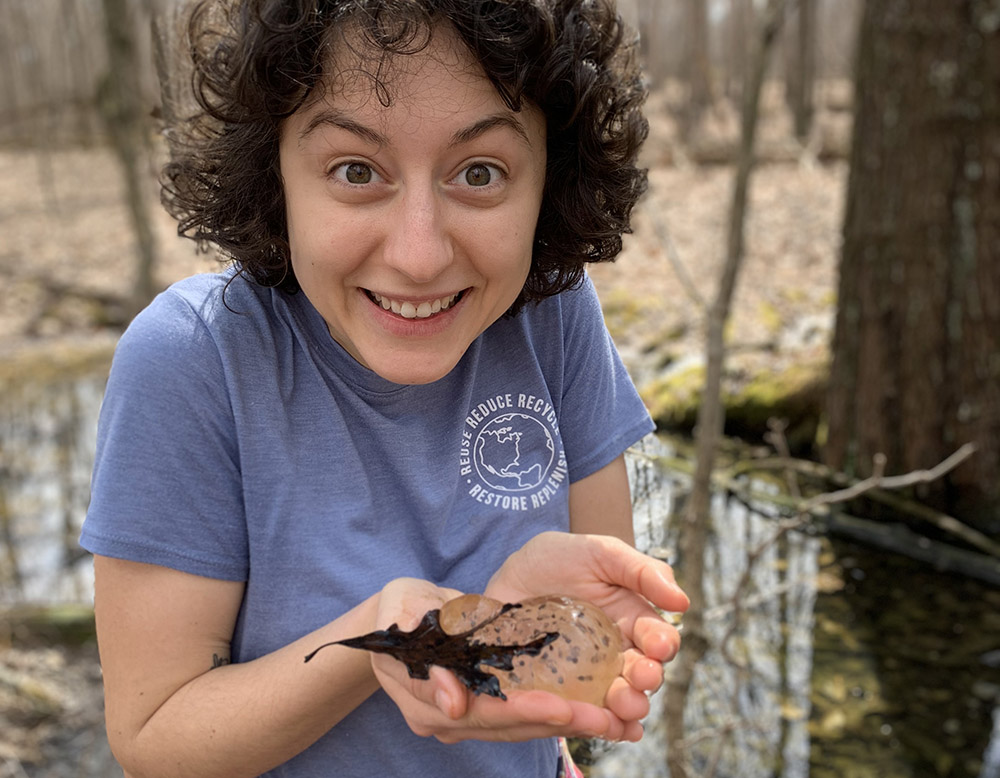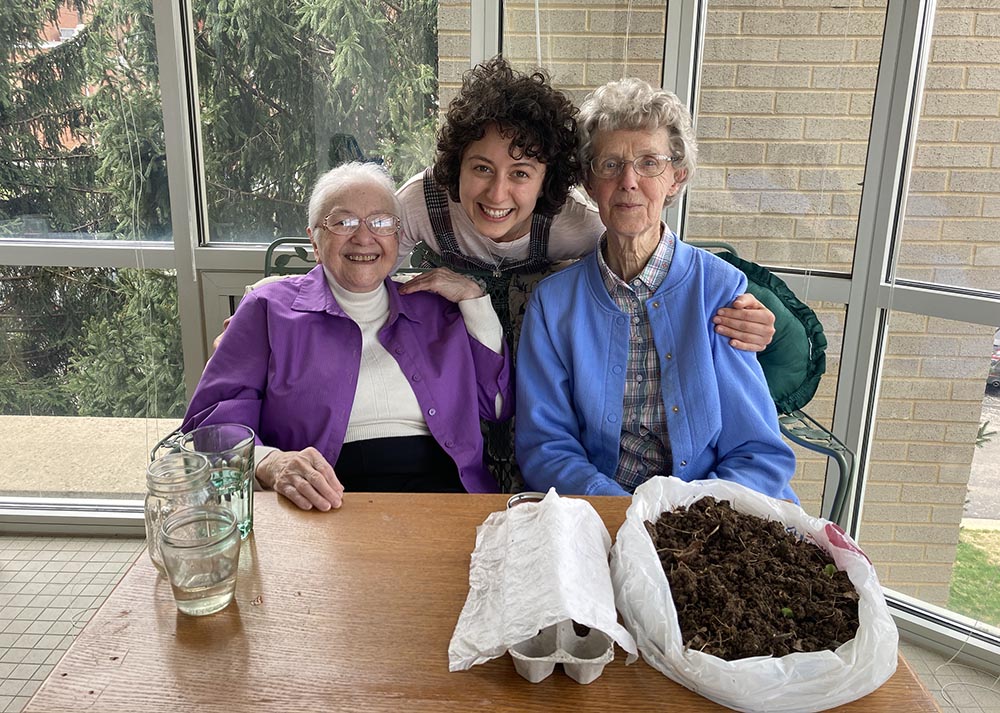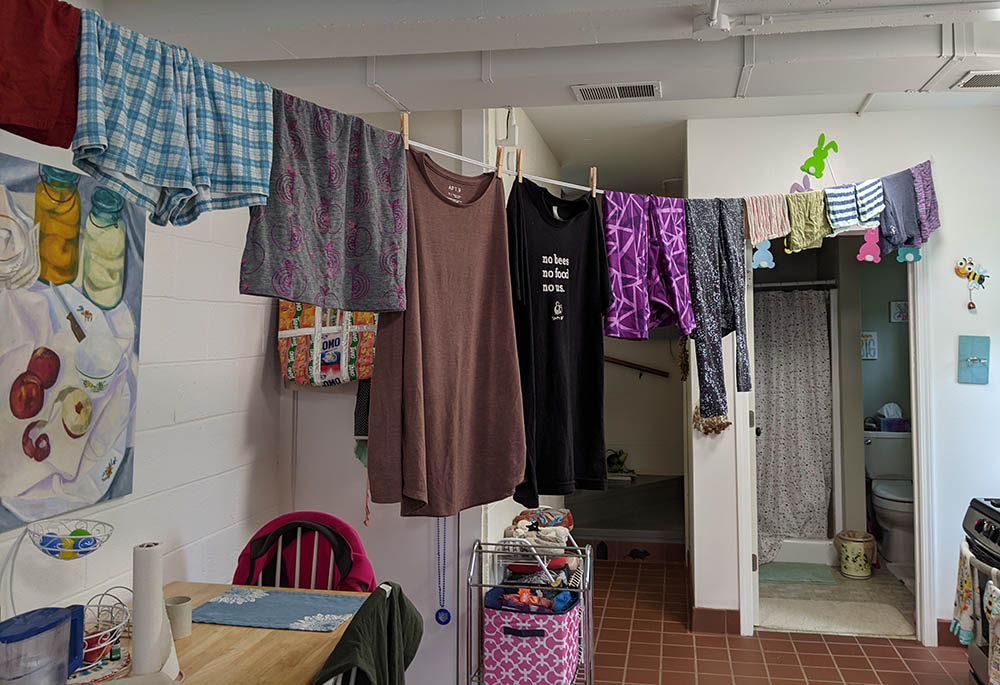
Eyes wide, Julia marvels at the amphibian eggs she's holding. Exploring the first signs of new life in vernal pools during springtime in Nazareth, Kentucky, reminds Julia that the health of our environment is as important to our well-being as it is to those critters that also call Earth home. (Courtesy of Kelly O'Mahony)
As a sustainability and climate educator serving with the Sisters of Charity of Nazareth, Kentucky, I spend a lot of time thinking about our common home: this lovely planet Earth.
More often than not, I find myself learning, teaching and researching what's happening at various levels on Earth, including working with my community to calculate our greenhouse gas emissions (with a goal of reducing them to zero) and exploring amphibious egg masses in vernal pools this spring. It's fascinating and oh-so-fun to share!
With Earth Day right around the corner on Friday, April 22, I thought it only appropriate to blend my passions for writing, justice and sustainability and tie them neatly into a bow in this blog post. Voilà!
Talking about climate change isn't always easy — I had to learn how to know when to stop writing on about my fifth draft of this piece — or brief. (Around 1,100 words, Global Sisters Report? I'm trying to save the world here!)
Jokes aside, let's dive in. Much like the mysteries of nature, we might be surprised with what comes up.
This year's Earth Day theme is "Invest in Our Planet." EarthDay.org, which sets the annual theme and serves as the "world's largest recruiter to the environmental movement," elaborates:
[Earth Day is] the day to take action not just because you care about the natural world, but because we all live on it. Every one of us needs a healthy Earth to support our jobs, livelihoods, health & survival, and happiness. A healthy planet is not an option — it is a necessity.
Preparing for this day and leaning into this theme, I hear a call beckoning us, beckoning me, to live more sustainably. After all, I am a part of the generation that will inherit the future of this Earth.

Love radiates in this photo of Julia, center, with Sr. Paschal Maria Fernicola, left, and Sr. Molly Thompson, both Sisters of Charity of Nazareth, Kentucky. Among the sisters at Nazareth, Julia's connection to community translates fluidly to love, hope and action through service. (Courtesy of Carolyn Cromer)
You see, I firmly believe that we all — myself included — carry a responsibility to live more sustainably on this Earth.
"Sustainability" has its origins as an ecological concept referring to how biological systems endure, remaining diverse. Now, however, sustainability is commonly used "to describe the viability of interdependent human and natural systems over time," as the North American Association for Environmental Education writes in its "Guidelines for Excellence: Community Engagement."
Further, the U.S. Environmental Protection Agency asserts, "Sustainability is based on a simple principle: Everything that we need for our survival and well-being depends, either directly or indirectly, on our natural environment."
Sustainability is, in short, living responsibly and living well. I'd like that for myself and future generations!
Unfortunately, the science has been telling us for decades that our pace of life and rate of growth are not sustainable. This is the world we inherit. Besides being metaphorically hard to swallow, our contributions to the current climate crisis as a species (however unintentional they may be) can also be difficult to comprehend amid the haze of a hundred-billion-dollar fossil-fuel industry and sympathetic structures and systems that bolster extractive ways of life.
However, the story of the day and the narrative promoted by this year's Earth Day theme is simple: Individuals have power.
In fact, a September 2020 report from the Stockholm Environment Institute and Oxfam cited that the world's wealthiest 10% were responsible for almost half of global emissions in 2015. Who are the world's wealthiest 10%? Anyone with an annual income of at least $38,000, which is most people in my life.
What can the world's wealthiest do with their power?
On a macro level, companies, governments, policies and practices need to change. We know that, as individuals, we vote not only with our ballots, but with our wallets. This is what investing in our planet looks like.

Line-drying clothes is one thing Julia does to live more sustainably and reduce her greenhouse gas emissions. Though not necessarily a high-impact climate activity, the practice of hanging, waiting and bringing down her clothes reminds her to live simply and be attentive to the condition of her products. (Julia Gerwe)
Investing in our planet can also look like simplicity, connection and hope.
By living more simply — namely, consuming and traveling less — we directly and indirectly emit less greenhouse gases.
But what about connection? What about hope?
In 1992 — before I was born, I will add, to provide context — Helen Caldicott, an Australian physician, author, and anti-nuclear advocate, wrote in If You Love This Planet: A Plan to Heal the Earth: "It is clear to me that unless we connect directly with the earth, we will not have the faintest clue why we should save it. We need to have dirt under our fingernails ... to really understand nature."
I don't think that the secret has changed. In fact, my own journey of climate awareness started with noticing, with presence.
Without even realizing it, I have lived acutely aware of the environments that have grounded me in each stage of my life. It is through these environments and the well-being of the communities I cherish within them that my passion for sustainability grows.
For example, growing up, I enjoyed hours of playing outside, camping, and exploring natural areas alongside my family in various burrows between Kentucky, Ohio and Indiana.
When I moved to the urban landscape of St. Louis for college in 2016, I became grounded in my community by seeking to learn about and engage in protesting social injustices arising from city structures rooted in racism.
Advertisement
In college, I studied and served abroad in South Africa through the Sibanye Cape Town program and found myself navigating a severe water crisis and observing the realities of resource depletion: namely, the disproportionate effects that catastrophes often have on marginalized communities.
Today, I find my physical body and mental health healing as a I move at a slower pace and find my ground closer to home at Nazareth, enjoying more locally grown foods and rich natural and human communities.
I'm not the first to identify this connection between community well-being and sustainability, and I won't be the last. As someone who thrives in the presence of community and cares deeply for equity in my community, it truly only makes sense that sustainability aligns with these values. In this way, love for my community is bolstered by connection to our shared physical environment. Connection lends itself to love.
In her book, Caldicott writes, "The only cure is love."
I also believe this.
Because I love my local community, I prioritize buying locally grown and made products. Because I love my global community, I try to do conscious research before buying new clothing to ensure that those making the clothing are treated justly and the materials are sourced sustainably.
In this way, love lends itself to hope, which inspires action.
Because I have built relationships with local community members, I can talk with them about alternatives to synthetic pesticides or ethical product sourcing. Because I know which brands and companies care for their employees and the Earth, I can make more informed decisions and encourage my friends, family and co-workers to do the same. That is investing in our planet.
This Earth Day, I challenge you to follow this trajectory from connection to love to hope and to action. You can start by getting some dirt under your fingernails. I know I will.







